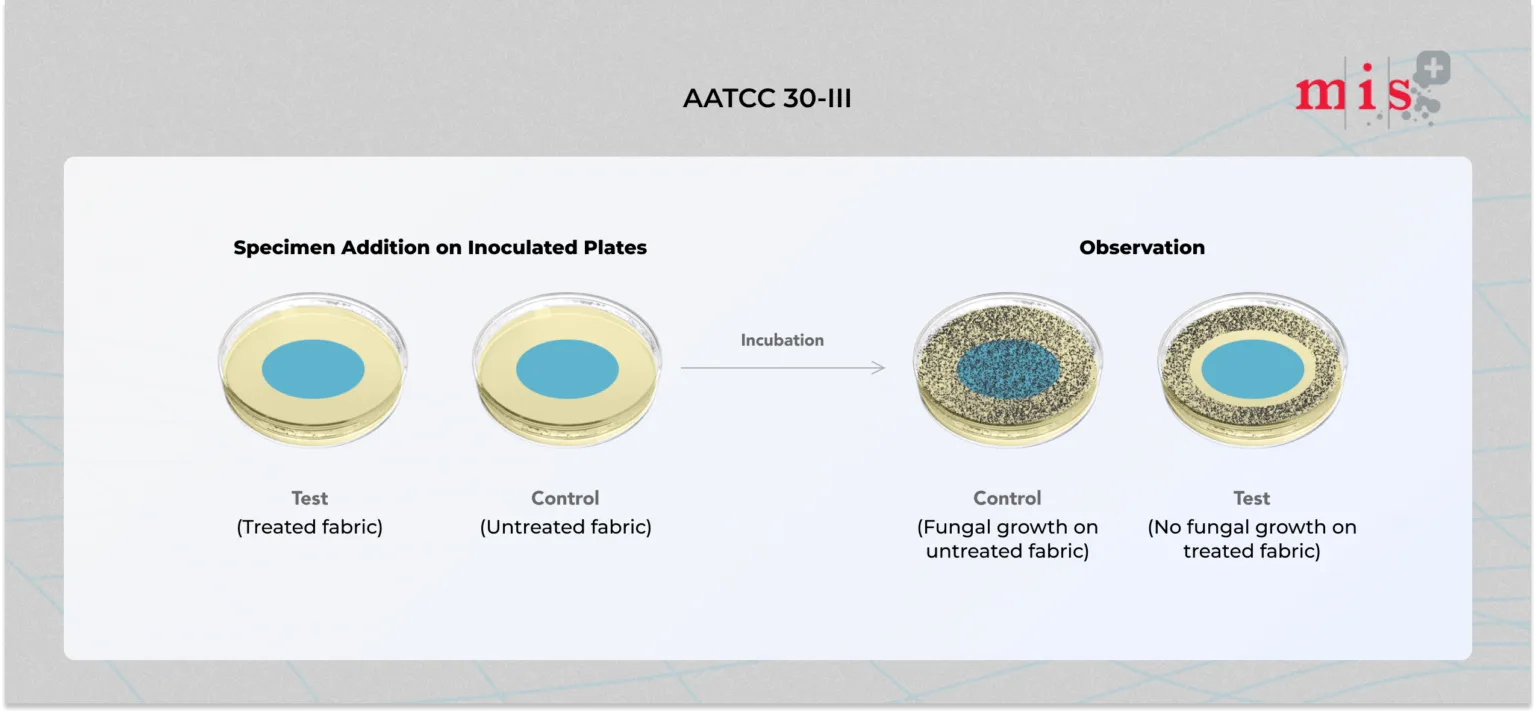- Swiss testing laboratory
AATCC 30

Hassle-free testing experience
Need to get a product tested? No worries! To and fro logistics are on us; we collect your products, test them and, deliver them back to you.
Related tests for you
- AATCC 100
- JIS L 1922
Quick understanding of the test
AATCC 30 – Antifungal Textile Test
- Aspergillus niger (ATCC-16888)
- Chaetomium globosum
- Penicillium varians
- Trichoderma viride
- AATCC 30 Test I – Soil Burial test method
- AATCC 30 Test II – Agar Plate, Chaetomium globosum
- AATCC 30 Test III – Agar Plate, Aspergillus niger
- AATCC 30 Test IV – Humidity Jar, Mixed Spore Suspension
- Helps manufacturers meet industry and regulatory standards for antifungal treatments.
- It offers multiple test methods suitable for various textiles and exposure conditions.
Turnaround Time
Do you have a product that needs testing?
Abstract
Products tested
Organisms tested
Organisms typically used in this method include Aspergillus niger (ATCC-16888), Chaetomium globosum, Penicillium varians, and Trichoderma viride.

Types of AATCC 30 Test
Methods
A. AATCC 30 Test I – Soil Burial test method
Test procedure
Soil bed preparation
- Air dried test soil is placed in containers (trays or boxes) to a depth of 13.0 ± 1.0 cm.
- Water is added gradually to achieve optimum moisture content. The step-up is then mixed thoroughly to avoid puddling.
- The soil is allowed to stand for 24 hours and sieved through a 6.4 mm mesh screen.
- Soil moisture content is maintained at 25 ± 5% by covering the container.
Sample preparation and incubation
- Textile samples (both treated and untreated) are prepared to a dimension of 15.0 ± 1.0 × 4.0 ± 0.5 cm.
- The samples are then buried horizontally in the soil bed, and covered with an additional 2.5 ± 0.5 cm layer of soil.
- The samples are incubated for 7 days at 28 ± 1°C.
Post-incubation handling
- Textile samples are removed from the soil and gently washed with water.
- The samples are air-dried at room temperature for 22 ± 4 hours.
- The samples are finally conditioned in an atmosphere of 64 ± 2% humidity and 24 ± 3°C for 24 hours.
Evaluation
- The breaking strength of the treated fabric is compared with the control (untreated) sample and any pre-exposed specimens before burying.
- The effectiveness of antifungal treatment is assessed by measuring the retained breaking strength after fungal exposure
B. AATCC 30 Test II – Agar Plate, Chaetomium globosum
Test procedure
Preparation:
- Test (treated) and control (untreated) samples are placed on a mineral salt agar medium.
- A 10-14-day-old inoculum of Chaetomium globosum is evenly distributed over the test samples using a sterile pipette.
- An equal amount of sterile water is added for control samples.
Incubation:
- The samples are incubated at 28 ± 1°C (82 ± 2°F) for a specific period.
Evaluation:
- After the incubation period, the samples are evaluated for the breakage strength.
- The antifungal resistance is assessed by comparing the treated fabric samples with the control samples.
AATCC 30 Test III – Agar Plate, Aspergillus niger
Test procedure
Preparation:
- Treated and control (untreated) specimens are placed on a sterilized mineral salt agar medium.
- A 7-14 day-old inoculum of Aspergillus niger (ATCC-16888) is evenly distributed over the test samples using a sterile pipette.
- For control samples, an equal amount of sterile water is added.
Incubation:
- Incubate all samples at a temperature of 28 ± 1°C for 14 days.
Evaluation:
- After the incubation period, the results are evaluated through microscopic examination of fungal growth on the samples.
AATCC 30 Test IV – Humidity Jar, Mixed Spore Suspension
Purpose: This test method is designed to determine the efficacy of textile materials to control mildew and non-pathogenic fungal growth. It is applicable for waterproof textile material intended for outdoor and above-ground use.
Test procedure
- Treated (control) and untreated (test) fabric samples are placed in respective jars.
- The samples are then sprayed with a mixed spore suspension containing mildew-causing organisms (Aspergillus niger, Penicillium varians, Trichoderma viride).
- The samples are incubated at 28 ± 1°C for 14 to 28 days and evaluated weekly for fungal growth.
- The percentage of surface area covered with fungal growth is assessed and recorded.
Importance
Ensuring product quality
Regulatory compliance
Enhancing Marketability
Supporting research and development
Environmental sustainability
Pros and cons of AATCC 30
Pros
- Comprehensive assessment: Provides a thorough evaluation of a textile’s susceptibility to mildew and rot.
- Realistic conditions: Tests are designed to simulate real-world conditions such as soil burial, high humidity, and exposure to specific fungi. This helps predict the performance of textiles in actual use scenarios.
- Standard test protocol: Uses standard test organisms (e.g., Chaetomium globosum, Aspergillus niger) and test conditions to ensure consistency and repeatability in testing.
- Regulatory compliance: Helps manufacturers meet industry and regulatory standards for antifungal treatments thereby, ensuring product safety and effectiveness before market launch.
- Enhanced product quality: Identifies potential issues with mildew and rot resistance early in the development process thus improving the overall quality and durability of the textile products.
Microbe Investigations Switzerland (MIS), we run antifungal activity assays on treated textiles and plastic materials used for daily activities, industrial purposes, and other areas susceptible to fungal growth. Our experts adhere to International Standards for achieving reliable, accurate, and reproducible results.
To get a quote on the AATCC 30 test and other related queries, get a free consultation from our expert here.
Frequently Asked Questions

DR. Martinoz Scholtz
At Microbe Investigations, we use Aspergillus niger (ATCC-16888) to perform the test.
This test measures antimicrobial effectiveness in textiles by examining their susceptibility to mildew and rot, as well as the efficacy of fungicides. The test involves exposing textiles to fungi and observing the growth of fungi.
This test complies with industry standards for textile safety by following stringent protocols for evaluating the mildew and rot resistance of textiles.
The benefits of testing before the product launch include ensuring antimicrobial treatment durability, preventing mildew and rot, testing textiles for real-world conditions, and improving consumer satisfaction.
Considerations when interpreting the testing results include the variability in environmental conditions, differences in fungal strains, and the specific use case of the textile.
Testing helps validate that your textile products are resistant to mildew and rot growth and the efficacy of the antifungal agent in inhibiting their growth which is required to meet regulatory requirements.
Meet the best of the blend of
R&D, Efficacy Testing,
Innovation and Passionate
Experts at MIS.







